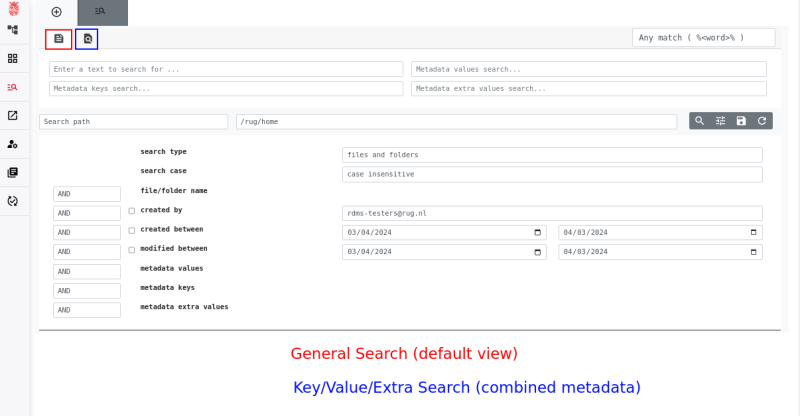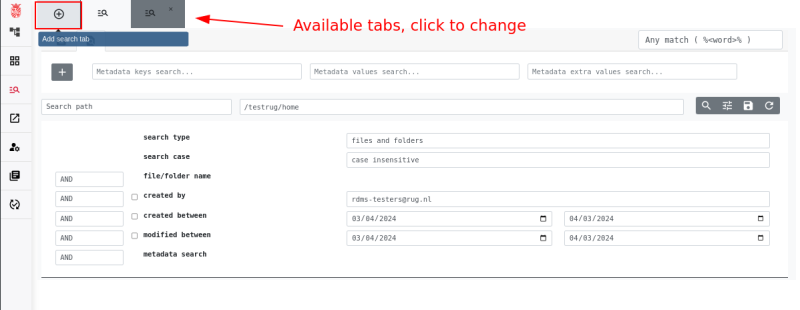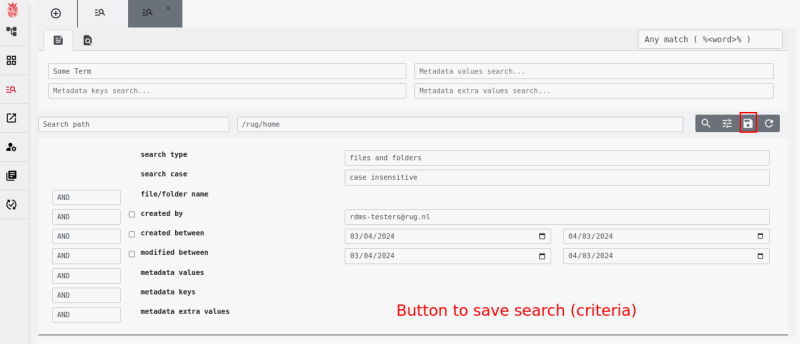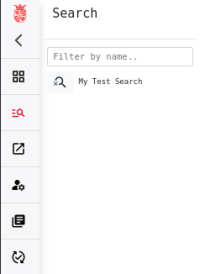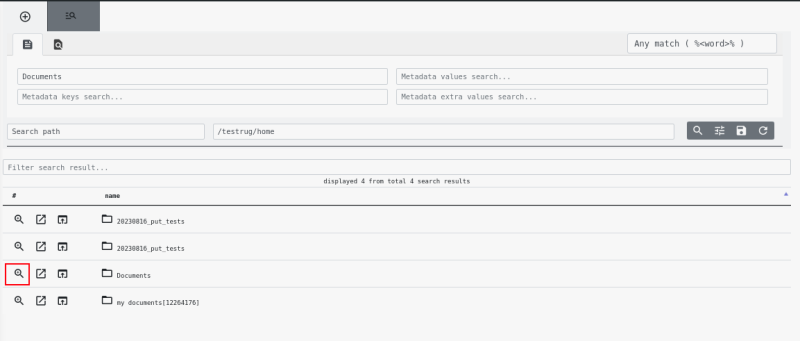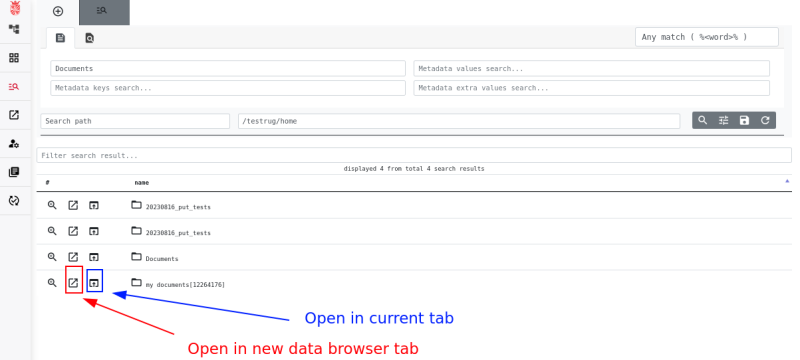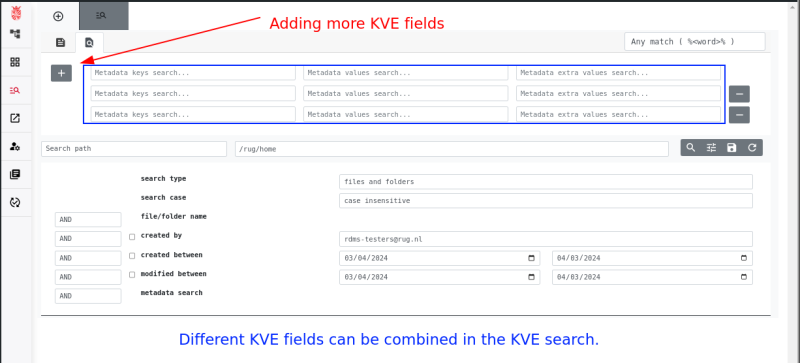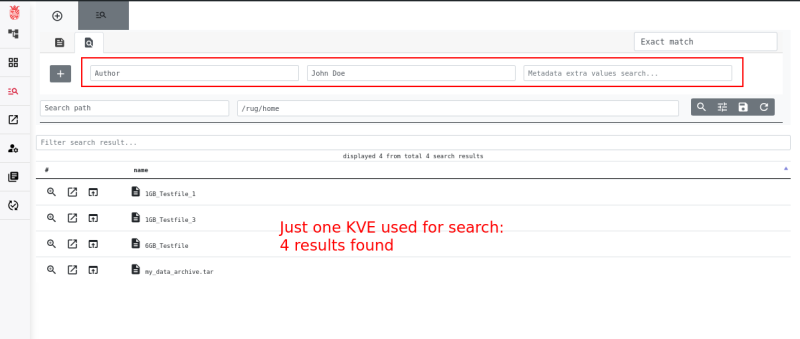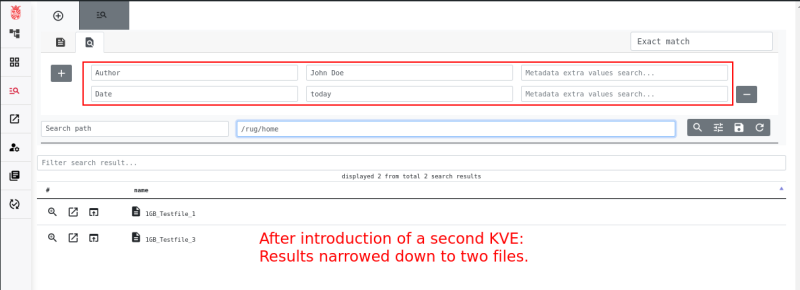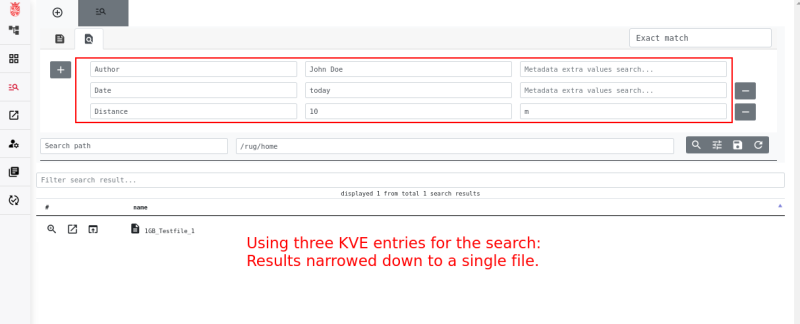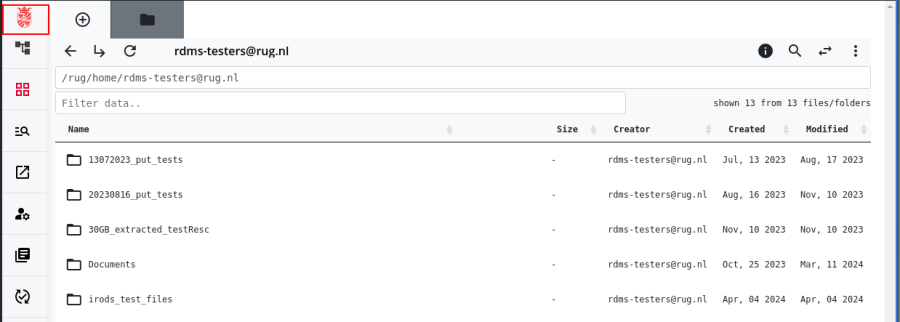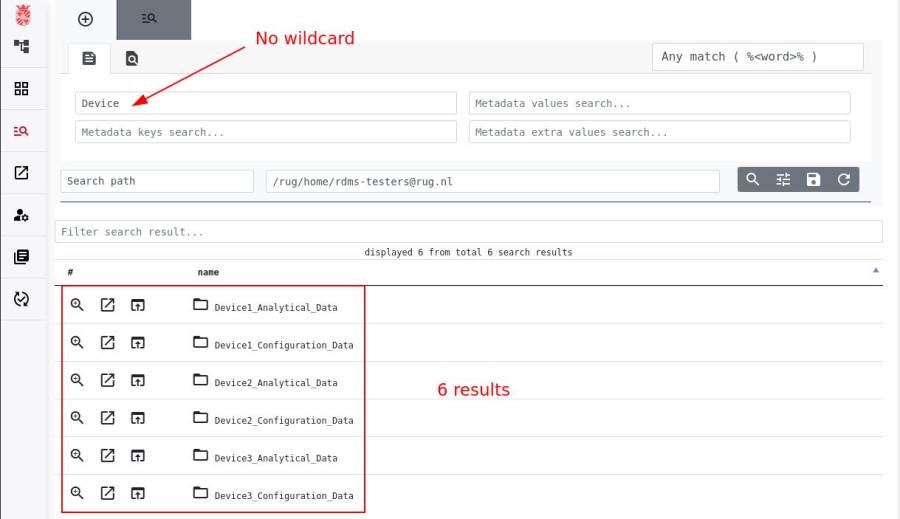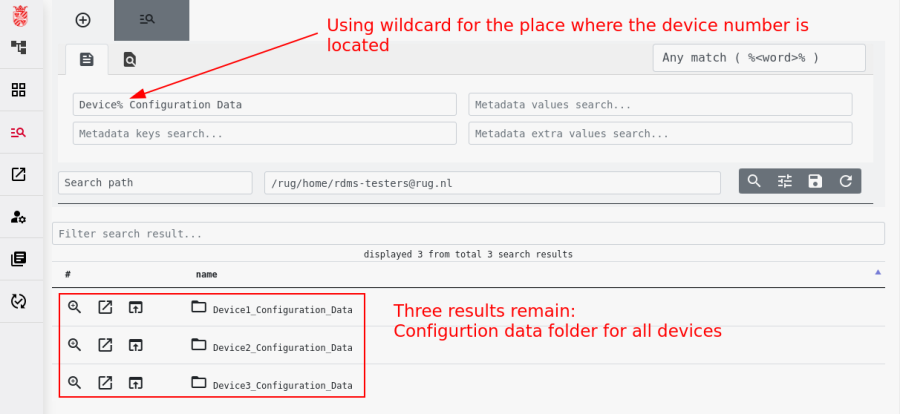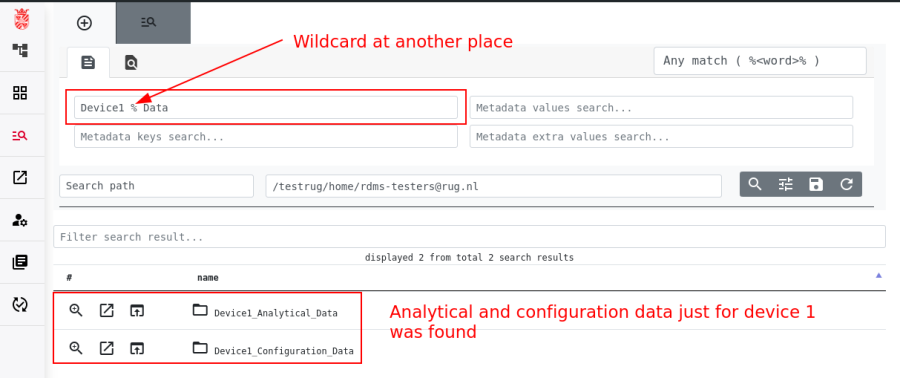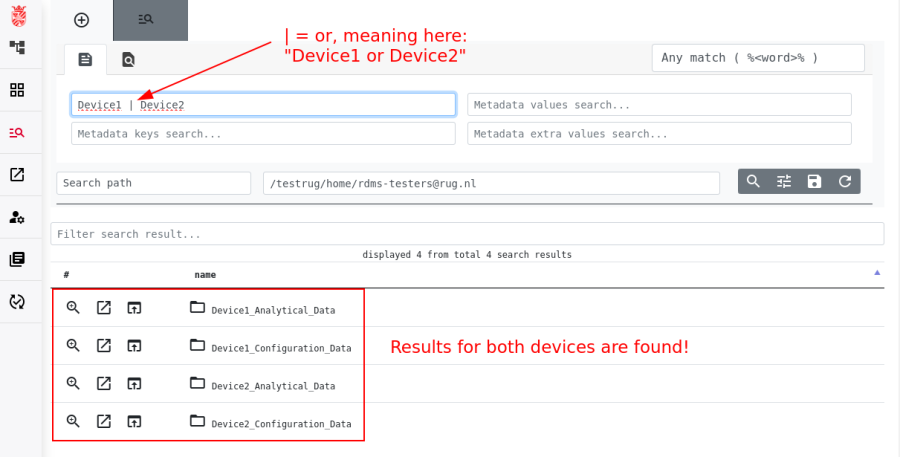This is an old revision of the document!
Search
The RDMS web interface comes with and extensive and flexible search functionality. Unlike other storage solutions, this search engine offers the advantage of utilizing metadata for exact data queries. Additionally, the integrated search engine also allows to make more elaborated queries/searches, such as combining multiple metadata entries.
This section will explain the basic functions of the integrated search and provide some more elaborated search/query examples using metadata.
Accessing RDMS Search
Accessing the search engine is possible via the left-sided menu in the web interface.
After logging in to the interface, simply click the ![]() button on the left side of the menu to open the search function in the current window.
button on the left side of the menu to open the search function in the current window.
General Functionality
General vs. Key/Value/Extra Search
The search functionality in the RDMS is available in two distinct options:
- General search: The general search allows you to find results based on various criteria.
- Key/Value/Extra (KVE) search: These search options is specifically designed for querying using multiple metadata entries simultaneously. You can access these search options via the
 button at the top of the search interface.
button at the top of the search interface.
You can change between these searche options by selecting the respective tab from the top of the search interface. Below you will find more examples demonstrating how to utilize these searches for both simple and more complex quearies in the RDMS.
Tabbed Searches
The top menu in the search allows you to add new search tabs via the ![]() button which will create a new search tab.
button which will create a new search tab.
Saved Searches
Additionally, it is possible to save searches for later re-use. To save a search, click the ![]() button in the search view after you specified the desired search terms (see below for examples on how to use the search).
button in the search view after you specified the desired search terms (see below for examples on how to use the search).
You will be asked to name the saved search. Specify a clear description of you search and then save it.

All your saved searches are visible in the interface.
Sub-Searches
Whenever a search result is found, the RDMS search allows to execute a subsequent search inside the desired location. This is especially helpful if the first search found a respective folder and then a consecutive search inside this folder should be executed.
To open the sub-search, first find the folder in which you want to search via the initial search, then click the magnifying glass button next to the folder name.
This will open a sub-search in a new tab where the folder location is already set as the search path. Inside the sub-search, you can then use either the general search or the KVE search (see below).
Note: You can of course also do sub-searches of sub-searches if this is needed. The process is the same as described here.
Opening Search Results
The RDMS search allows to open search results in two different ways:
 button: Open the result in a new data browser tab. This will keep the initial search active in the parent tab.
button: Open the result in a new data browser tab. This will keep the initial search active in the parent tab. button: Open the result in data browser. This opens the search result (location) in the data browser without opening a new tab.
button: Open the result in data browser. This opens the search result (location) in the data browser without opening a new tab.
Using RDMS Search
General Search
To execute a basic search for data, you can specify the search term in the top-right box in the search engine and then execute the search by hitting the magnifying glass symbol:
This will search for the specified search term using the standard search parameters.
To make the search results more precise, you can adjust the search criteria. For example, you can specify that just data created in a certain time frame should be shown, that you want to see files only, that just a certain RDMS path should be search, and much more.
In the screenshot above, you can see the three different areas where you can specify the search criteria in the main search view:
- <html>Blue</html>: Here you can specify the path which should be searched. You can specify a RDMS path by hand, but there are also several pre-defined values possible (e.g. “My home” or “All”).
- <html>Red</html>: Here you can specify more details about the search mode. For example, you can say if you want to see files or folders, if you want to find just data created in a certain time frame, or that your search should be case sensitive or not. If you do not see this menu, you can reveal it by clicking the
 button.
button. - <html>Green</html>: This additional box allows to further fine-tune the search pattern. In this field, you select how the entered search term(s) should be interpreted. “Any match (%<word>%)” will find the search term either alone or contained in another term (e.g. searching for “time” would also be positive for “timecapsule” or “walltime”). “Exact match” on the other hand just gives a positive search result if the exact search term(s) where found. The two other selection criteria, “Right truncated (<word>%)” and “Left truncated (%<word>)”, are positive if the search term was found either at the start or end, respectively.
Note:
- This simple search will display results where the search term is found at various places. For example, it will find results where the search term is in the file name, but also where it is found in the metadata.
Search using Metadata
While the general search view can be also used to search based on metadata, the separate key/value/extra search was specifically designed to facilitate searches/queries that use multiple, combined metadata values as the search criteria. The metadata-based search will be therefore explained for this kind of search.
First, access the key/value/extra search from the top of the search view.
You will see that the key/value/extra search contains search fields for metadata keys (K), metadata values (V), and metadata extra values (E) while the “Enter a text to search for” function that was available in the general search is not available here.
Instead, the KVE search allows to add new KVE fields by selecting the ![]() button, and the
button, and the ![]() button is used to remove it again.
button is used to remove it again.
The usage of this functionality can be seen in the following example:
In this example, we used a single KVE as search criteria (Key: “Author”, Value: “John Doe”) which resulted in four files being found by the search.
If we now introduce another KVE (Key: “Date”, Value: “today”) and repeat the search we get:
So instead of seeing the four results as before, we now just get two of the previous results shown. This results from the fact that the remaining two entries had an Author: John Doe metadata entry, but not a Date: today entry. Accordingly, they are removed from the second search.
If a third criteria is introduce even less results are shown:
Note: The function of combining multiple KVE entries to narrow down search results makes the metadata-based search of the RDMS web interface very powerful. This function is especially helpful for cases where there is a lot of data with distinct, but similar metadata entries.
Further Tips
Using Fast Search
Next to the search function explained so far, the RDMS also has a fast search that can be used to make simple searches from any location in the RDMS.
To access the fast search, simply click on the UG logo in the top-left corner of the web interface:
A menu will be revealed where you can either specify a RDMS path to directly open it (left field) or do a fast search (right fields):
More Advanced Search Syntax
While it was shown above how files and folders can be found based on different parameters (name, metadata, etc.), and it was also shown that search criteria can be adjusted via the available menu to fine-tune search results, we will elaborate here which additional tricks you can use in the search syntax.
When you specify a search term in the field, it is important to know that you can also used additional wildcard cards in your query. These wildcard characters are
_: The underscore is the wildcard for one sign. So searching for “Device_-Data” will find results for “DeviceA-Data”, “DeviceB-Data”, and so on, but no result for “DeviceXXX-Data”.%: The percentage sign is the wildcard for an undefined amount of signs. So searching for “Device%-Data” will find the same results as described for “Device_-Data”, but additionally also “DeviceXXX-Data”.
It is important to note that this wildcard characters can be of course also used for the search based on metadata.
To see how we can use this wildcards for further filtering of our query, take a look at this example where we first searched for “Device” which gave us in this case six similarly, but still slightly differently named folders:
Assuming that we now just want to find the configuration data for all the devices 1-3, we could use a search term like “Device%_Configuration_Data” which will yield:
As we used the % wildcard character in this example, this would also find results like “Device312_Configuration_Data” or “DeviceBuilding4_Configuration_Data”.
In another example, we want to find both, the analytical and configuration data folder for our “Device1”, but we do not want to get the results for the other devices. This could be achieved with a query of the form “Device1_%_Data” as seen here:
Next to the wildcard characters, it is also possible to use & and | in the search will will act as “and” and “or” operators, respectively.
Let's assume that you want to find the results that contain either “Device1” or “Device2” in their name. A search query for this could use the “or” statement to connect both terms like “Device1 | Device2” which will yield:
Note:
As seen above, we can use wildcards to further fine-tune our search results. With the other settings that are available in the search interface as well as with the possibility to use metadata, this offers a lot of capability to modify searches to yield our desired results.
